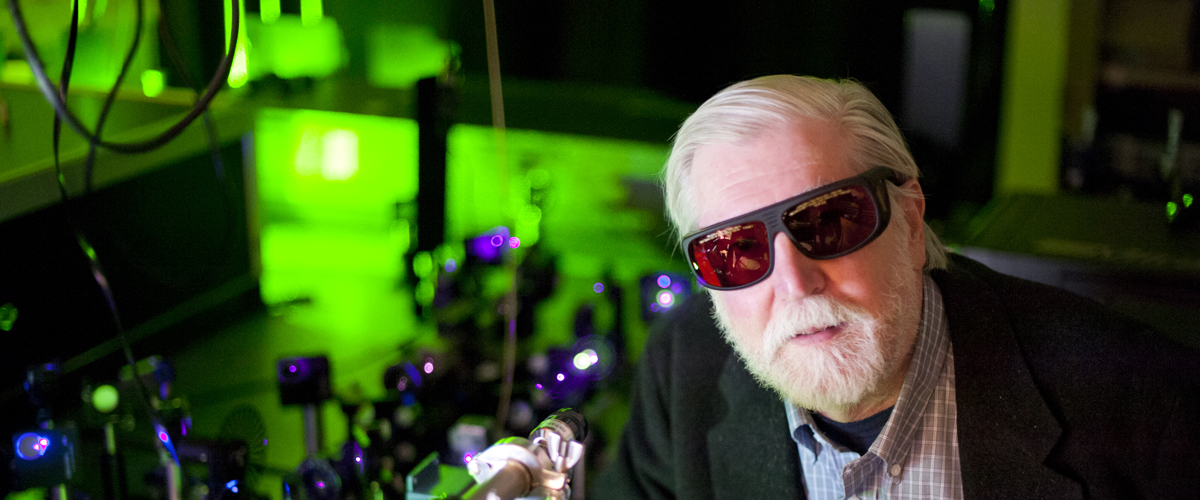By Gwendolyn Schanker, Journalism and Biology, 2018
In a paper published in Nature Chemistry, Northeastern University physics professor Paul Champion, uses ultrafast laser technology to determine how physics and chemistry combine to make biology happen.
Champion’s research for this paper centers on biological proton transport, which plays an important role in enzyme catalysis and energy storage associated with cell respiration.
Champion says the paper, which was co-authored by local and international collaborators, “challenges the classical view of proton transport” by showing how a process known as quantum mechanical tunneling is involved in moving protons along water “wires” within proteins.
Normally in a reaction, molecules have to go over a thermodynamic barrier that involves making or breaking chemical bonds. With tunneling, protons can go through the barriers that bind them to atoms and this allows them to travel more efficiently and arrive at destinations that would otherwise be impossible.
“Tunneling of protons at room temperature is happening on a nanosecond time scale, which is surprising and much faster than the classical over-barrier process,” Champion said. “Quantum mechanical tunneling also helps to explain how a preferred direction is established when protons are transported across the mitochondrial membrane in order to create an electrochemical potential.”
Tunneling happens at room temperature because the oxygen atoms of a water molecule and an amino acid are connected by a hydrogen bond so they can undergo vibrational motion. “Thermal excitations cause the two oxygen atoms to bounce back and forth like they’re on a spring,” Champion said. “It’s at the point when they’re closer that the tunneling reaction takes place.”
In this reaction, amino acids along the wire provide stability and allow the protons to flow much more easily in one direction, based on a “tunnel diode” effect. This type of control could have future implications for important power sources like batteries, as well as for understanding how biological organelles and enzymes perform their varied functions.
“It’s a potentially very clever way of getting protons to build up on one side of a membrane,” Champion said. “Among other things, the mitochondrion is a highly evolved biological battery.”
The researchers used the green fluorescent protein (GFP) to observe the tunneling process. First isolated from a species of jellyfish, the protein emits a bright green fluorescent light when it is expressed, making it useful for imaging a wide variety of processes in living cells. “You can tag the GFP gene onto DNA so that when certain target genes are expressed, the green fluorescent protein gets expressed as well,” Champion explained. The scientists who discovered and characterized GFP were awarded a Nobel Prize in 2008.
Observing the proton tunneling process was only possible because of the lab’s highly evolved laser technology, which has steadily advanced since Champion first started working at Northeastern in 1984.
The ultrafast, optical laser system that the team used was built in the lab and it allows the researchers to probe the dynamic response of biological samples over many orders of magnitude in time as well as the dependence on temperature. This allowed the researchers to observe the GFP as it passed through the various states of its photocycle: particularly when it transports protons (or deuterons) back to reform its initial state.
“Nobody’s ever looked at transport using proton “wires” before, because nobody’s been able to trigger the reaction,” Champion said. “We were originally going to study the excited state processes, but by pure luck realized that we could see the ground-state, thermally driven processes that are more relevant to biology.”
For Champion, that’s one of the most exciting parts about working in experimental physics. “A lot of the best science involves observing something you didn’t expect,” he said.
Among Champion’s collaborators in the unexpected were graduate student Bridget Salna, postdoctoral researcher Abdelkrim Benabbas, and associate physics professor Timothy Sage. On the international side, the team worked with Jasper van Thor at Imperial College London. The research was made possible through a grant with the National Science Foundation and the Engineering and Physical Sciences Research Council in the U.K. Champion pointed out that the project not only involved collaboration between different age groups and countries, but was also an interdisciplinary effort.
“Complicated questions like this need input from different sectors of the scientific world,” he said. “When you team up to attack a difficult problem, you can bring the best of both worlds together and do unique things. That’s what we’ve done here.”

